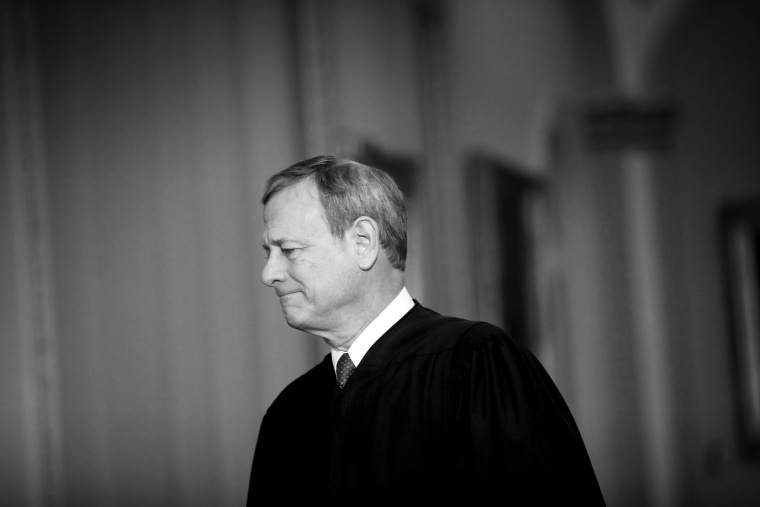If people associate one issue with the U.S. Supreme Court, it is typically abortion. Pro-choice advocates see the constitutional right to abortion access hanging by a thread. Pro-life advocates see the same thing; they just view that as a victory.
Chief Justice John Roberts, the new center of the court, will likely determine the future of reproductive rights in America.
Chief Justice John Roberts, the new center of the court, will likely determine the future of reproductive rights in America. That role used to be filled by Justice Anthony Kennedy, widely hailed as a moderate jurist. But Kennedy can actually best be described as a conservative who occasionally voted with liberals on controversial issues like abortion rights, affirmative action, gay rights and the death penalty. When Kennedy retired, he was replaced by one of his former law clerks, Brett Kavanaugh, in 2019. One of the big questions still left open by Kavanaugh's replacement of Kennedy will be the fate of abortion rights.
This term brings us the first chance to see how Kavanaugh's presence on the court, and Roberts' assumption of the role of its leader and center, could shape the future of abortion rights. June Medical Services v. Russo, which will be argued Wednesday, concerns a law passed in Louisiana that said physicians who perform abortions must have admitting privileges at a local hospital (one within 30 miles of where the abortion is performed). If the law were to take effect, it would likely mean that one clinic in the entire state of Louisiana would be legally able to offer abortions.
Back in 2016, when Kennedy was still sitting on the bench, the court struck down a substantially similar, if not virtually identical, law enacted in Texas. The Texas law also mandated that physicians who perform abortions have admitting privileges at a local hospital (again, within 30 miles). In that case, had the law been upheld, it likely would have reduced the number of abortion clinics in Texas to nine. The court struck down the law as an undue burden on a woman's right to abortion access. Kennedy joined the liberal justices in voting to invalidate Texas' law. Roberts and Justices Clarence Thomas and Samuel Alito voted to uphold the restriction. (Justice Antonin Scalia passed away shortly before the court decided the case and was eventually replaced by conservative Justice Neil Gorsuch.)
The primary issue in the June Medical case this week is whether the court will follow the decision it made only four years ago and strike down Louisiana's law. Louisiana has tried to differentiate its law from Texas' because the geographies of the states are different and the demand for abortion is different. But this truly is a distinction without a legal difference. The 5th U.S. Circuit Court of Appeals voted 2-1 to uphold Louisiana's restriction, based on thin reasoning in which the court tried to distinguish the two state laws.
The question of whether or not the court will respect precedent is a big one. The principle of stare decisis says courts should respect precedent. If the court ignores a recent precedent, it will prove the justices are not just "calling balls and strikes," as Roberts himself said a few years ago, and applying the facts of each case to the law. Instead, it will demonstrate that the court is actively moving the law in different directions depending on the personal beliefs of justices.
When those challenging the law appealed to the Supreme Court, Roberts voted with the liberals to issue a stay (meaning to pause implementation of Louisiana's law) until the court heard the case. This is not necessarily an indication of Roberts' willingness to strike down Louisiana's law. Roberts' vote likely indicates nothing other than his view that it's better to play the long game when trying to move the law in one direction — in this case, toward allowing states to legally impose many, many restrictions on a woman's ability to gain access to an abortion.
If the court ignores a recent precedent it will prove the justices are not just “calling balls and strikes,” as Roberts himself said a few years ago.
Still, it remains to be seen which option is more important to Roberts. Behind door No. 1? Respecting Supreme Court precedent and maintaining the integrity of the court. Door No. 2? Voting consistent with his previous position that Louisiana's law does not present an undue burden on abortion access. Door No. 2 represents a significant erosion of a woman's constitutional right to choose.
There may actually be another option — let's call it door No. 3, or perhaps Roberts' escape hatch. One of the issues is whether the physician abortion providers are the proper people to bring the case to the court. Put another way, the question is whether the abortion providers have standing to sue in federal court on behalf of women who want access to abortions. The abortion providers have standing if they suffered a real, concrete harm and if that harm can be remedied by winning their case. Louisiana argues that women who want to obtain abortions themselves must sue and that abortion providers cannot act as a proxy. Those challenging the law claim that Louisiana gave up its ability to challenge the physicians' standing earlier in the case and that, in any case, the physicians do have proper standing under applicable Supreme Court cases.
If the court rules that the physicians lack standing to sue, it would upset its standing jurisprudence, but it would leave intact its four-year-old abortion decision and therefore allow the court to dodge a big, controversial question in a big, controversial election year. This kick-the-can-down-the-road approach will work for only so long; other abortion cases are winding their way up through the court system. But some delay could create just the breathing room that Roberts needs before overturning recent case law.


